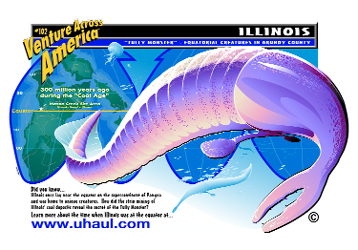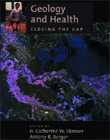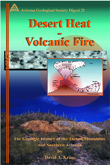Geotimes

Untitled Document

Geomedia
Geotimes.org offers
each month's book reviews, list of new books, book ordering information and new
maps.
Check out this month's On
the Web links, your connection to earth science friendly Web sites. The
popular Geomedia feature now available by topic.
Feature:
Geologic wonders hit the highway
Book Reviews:
Geology and Health: Closing the Gap
Desert Heat — Volcanic Fire
On the Shelf:
Online exclusive: The
Winelands of Britain: Past, Present, and Prospective
Terroir: The Role of Geology, Climate, and Culture in the
Making of French Wines
Geologic Wonders
Geologic wonders hit the highway
 On
road trips and family vacations unwinding this summer across North America,
travelers have shared the road with a 12-million-year-old rhinoceros, a 16-foot-long
turtle and a strange purple invertebrate known as the “Tully Monster.”
No, these critters aren’t driving a convertible in the next lane; they
are fossils, rendered as colorful graphics on the sides of U-Haul trucks.
On
road trips and family vacations unwinding this summer across North America,
travelers have shared the road with a 12-million-year-old rhinoceros, a 16-foot-long
turtle and a strange purple invertebrate known as the “Tully Monster.”
No, these critters aren’t driving a convertible in the next lane; they
are fossils, rendered as colorful graphics on the sides of U-Haul trucks.
Geologically themed graphics, such as
this one of the “Tully Monster,” adorn U-Haul trucks across the United
States. Image courtesy U-Haul.
The rhino is Teleoceras. The turtle is Archelon. And the Tully Monster, or Tullimonstrum
gregarium, might be a mollusk, or it might be a worm, but no one is quite
sure. Other U-Haul trucks bear illustrations of Arkansas’ Crater of Diamonds,
Kentucky’s Mammoth Cave and Utah’s Canyons of the Escalante. The U-Haul
SuperGraphics program details these geological curiosities on the sides of their
fleet of panel trucks as a public service. It is a singular program, showing
the average person everything from the Manson meteor crater in Iowa to the fluorescent
minerals of New Jersey’s Franklin and Sterling Mines, all on the side of
a truck.
These illustrations follow an earlier series that, beginning in 1988, documented
nationally renowned aspects of cities, states and Canadian provinces. The current
“Venture Across America” series, which was initiated in 1997, focuses
on more enigmatic local topics. Although most deal with geology, there are also
graphics exploring enormous mushrooms, ghost orchids and even the alleged UFO
crash in Roswell, N.M.
The graphics have a uniform format, appearing at a slight tilt, with a serigraph-like
appearance. Because each color is its own block of ink, U-Haul Senior Art Director
Monique Meadows says that “what you get is something that looks more like
art and less like pre-fab advertising.”
The images often have multiple components. For example, the Tully Monster swims
in front of a map of the world, with the Carboniferous location of Illinois
marked on the Equator. In the Manson crater graphic, the fiery meteor streaks
past a complicated mathematical equation. The Franklin and Sterling Mines graphic
bears the mineral formula for hardystonite (Ca2ZnSi2O7)
lurking behind the miner and his fluorescent hand samples.
A lot of people see the U-Haul graphics. The trucks are out in front of the
viewing public every day, with each design applied as a giant decal onto an
average of 600 of U-Haul’s 89,000 trucks.
“It’s a novel way to bring unique things to the attention of the public,”
says Donald Mikulic of the Illinois State Geological Survey. Mikulic was consulted
for the Tully Monster graphic, and he approves of U-Haul’s efforts at scientific
accuracy. “They put a lot of effort into getting it right,” he says.
An emphasis on credibility leads the eight-person U-Haul art team to consult
directly with the top researchers on each topic. “We don’t want to
be sloppy about it,” Meadows says.
There is only so much a graphic can convey at 60 miles per hour, however. To
supplement the eye-catching graphics, U-Haul maintains separate educational
Web sites that develop the story surrounding most topics. These Web sites, also
designed by U-Haul’s team, are exemplars of innovative design, with a sophisticated
sense of space and color balance. The geological information is presented in
language geared for the general public, with a suite of links for interested
visitors to pursue further.
The team is continually searching for fresh topic ideas. New releases in 2004
include New Hampshire tectonics and John Wesley Powell’s time in Wyoming.
The team’s brainstorming frequently finds its inspiration in the earth
sciences. “To find things that are unusual, we keep coming back to the
scientific world,” Meadows says. “Geology keeps speaking to us.”
Callan Bentley
Geotimes contributing writer
Link:
Venture
Across America on UHaul website
Back to top
Book Review
 |
Geology and Health: Closing the Gap
edited by H. Catherine W. Skinner, Anthony R. Berger. Oxford University
Press, 2004.
ISBN 0 195 16204 8. Hardcover, $75.
|
Bridging New Frontiers
Geoff Plumlee
One of the many exciting recent trends in the earth sciences is the expanding
recognition of how the geologic environment influences health. Geology and
Health: Closing the Gap is an appealing compendium of concise, easy-to-read
papers that illustrate past successes, future opportunities and ongoing societal
needs for collaborative earth and health science research. As noted by the editors
in the introduction, the book presents a sampling of the many challenges looming
in this exciting field, in hope of inspiring new research insights and future
collaborations between geoscientists and health scientists.
The editors are well-suited for the challenges of pulling together a volume
that will be of interest to both earth and health scientists. The book clearly
benefits from co-editor Catherine Skinner’s pioneering, long-term interactions
with the medical community on asbestos mineralogy and bone mineralogy. The editors
have done a laudable job in compiling contributions from scientists representing
a broad range of earth, life and medical science expertise, with perspectives
from many countries.
An overview chapter by co-editor Anthony Berger describes medical geology as
“the study of the linkages between natural geological factors and the health
and well-being of humans and other organisms.” The chapter provides insights
into why the crossover between earth and health science has not progressed further.
Berger also examines why health threats tied to variations in the geochemical
environment should be considered as natural hazards akin to those posed by earthquakes
or volcanoes.
Organized into three sections, each of the volume’s papers is preceded
by a helpful overview describing the section’s papers in the context of
prior research and societal needs. The first section on natural geologic (or
geogenic) health hazards delineates between physical hazards (termed “obvious
and immediate”) and chemical hazards (termed “silent and long-term”).
Papers in this section provide a uniformly fascinating tour through a wide variety
of natural health hazards.
One paper, for example, makes a compelling case that increased rates of illness
and human mortality in rural England from 1783 to 1784 could be tied to pollution
from volcanic gases produced during the Laki fissure eruption in Iceland. Another
paper examines the geogenic nature of endemic arsenic poisoning (from drinking
water in arsenic-rich geologic terranes or from combustion of arsenic-rich coals).
The arsenic paper also presents results of tests examining how dietary selenium
supplements might enhance arsenic elimination from the body and therefore help
mitigate effects of arsenic poisoning. Although dental amalgam is not a natural
hazard per se, two intriguing papers in this section describe processes of mercury
uptake by the body from dental fillings.
Papers in the second section examine potential health issues resulting from
diverse anthropogenic changes to the geologic environment. A study of an ancient
copper district in Jordan, for example, uses sediment and human bone chemistry
analyses to show that copper mining and smelting locally affected the environment
and human health at least 2,500 years before present. Another paper discusses
the links between endocrine-disrupting chemicals (examples of organic contaminants
that are relatively recent in origin but growing in their magnitude and impact)
and hormonal cancers such as breast and prostate cancer. The paper also conveys
how earth science investigations are needed to help quantify the mechanisms
by which these contaminants are distributed and degraded in the environment.
The third section of the book illustrates some of the many ways that researchers
can identify and quantify potential health hazards. Two chapters illustrate
that the human body is itself mineralized, both beneficially (bones are largely
made up of hydroxylapatite) and detrimentally (crystals of cholesterol and hydroxylapatite
precipitated on arterial walls can lead to cardiovascular disease). The papers
also illustrate a role for earth science in understanding how bone material
tracks the global environment in which it grows, and possibly in helping unravel
ways that crystalline arterial deposits can be treated more effectively through
enhanced dissolution.
A final integrative summary by the editors identifies some key areas in need
of further interdisciplinary collaborations and areas where such collaborations
have reaped rewards. The editors note that much of the driving force for interdisciplinary
earth and health science research has in the past been from the earth science
community. Perhaps this is in part because earth scientists routinely have to
integrate information from many different disciplines to solve their particular
research problem. Although differences in technical vocabulary and research
approach have been a challenge to such cross-disciplinary interactions, the
book’s summary also illustrates ways that earth scientists have been and
can be successful in engaging their counterparts in the medical and life science
communities.
Geology and Health: Closing the Gap provides both earth scientists and
life scientists a fascinating and diverse overview of how health can be influenced
by the geologic environment, both naturally and as a result of anthropogenic
changes. The papers, though short, uniformly serve their purpose by leaving
the reader satisfied but with interest piqued to learn more and to partake of
the many research challenges to come in medical geology.
Plumlee is research geochemist
at the U.S. Geological Survey (USGS) in Denver, Colo. In April 2003, he helped
to organize a conference on human health at the USGS headquarters in Reston, Va.
E-mail: gplumlee@usgs.gov.
Back to top
Book Review
 |
Desert Heat — Volcanic Fire
David A. Kring, Arizona Geological Survey, 2002.
Paperback, $16.
|
Summer reading in Arizona
Dawn H. Garcia
While I was spending time in the Sonoran Desert, Desert Heat — Volcanic
Fire caught my attention as appropriate reading for the summertime. Temperatures
were hovering around the triple digits, and “heat” was the operative
word. But David Kring’s recent book makes interesting reading for Tucson’s
tourists at any time of year and for locals who want to put some meat into their
knowledge of the Tucson area.
Kring, a professor at the University of Arizona, has put together a slim, colorful
paperback loaded with easy-to-understand graphics and maps. The geologic history
of southern Arizona and specifically of the Tucson Mountains is described in
enticing language, such as the description of so-called sky islands being “a
flotilla of ships on a sea of sand,” evoking an image of individual mountain
ranges popping up from the flat basin floor.
The outpouring of information may challenge nongeologists, but an appendix of
local minerals and a glossary at the end of the book help. Hikers and naturalists
will find this reading a quick Geology 101 course. Trained geologists will appreciate
the details described for the area.
Kring walks the reader through the geologic evidence that was used to put together
the history of the area and explains the processes that formed the rocks found
in the Tucson Mountains. After imagining the catastrophic forces of that time
period, it is difficult to look at the rocks underfoot in quite the same way.
The volcanic activity is also discussed on a regional scale for southern Arizona
during the late Cretaceous.
The second half of the book summarizes all rock formations in the Tucson Mountains,
starting with the small amounts of Precambrian (3.8 billion years ago) and Paleozoic
(545 million years ago) rocks exposed today and continues through the most recent
sediments that are being produced as the Tucson Mountains erode. Kring throws
in a number of additional subjects related to the area, including detachment
faulting (associated with the sky islands in the southern Arizona landscape);
ice-age mammals (though glaciers didn’t reach the area, the local climate
was affected); and recent sedimentary and erosional processes (at the current
rate, the Tucson Mountains will be completely eroded in 7 million years). He
also discusses the state’s numerous mineral deposits, including copper,
which supplies half of the U.S. copper production.
This is a good book for Tucsonans to keep in the guest bedroom for out-of-town
visitors, and will inspire readers in other areas to plan a trip to see all
the action for themselves.
Garcia is a registered geologist
who specializes in groundwater contamination assessments. She lives, works and
plays in Tucson.
Back to top
On
the shelf
ONLINE EXCLUSIVE
The Winelands of Britain:
Past, Present, and Prospective
by Richard C. Selley
Published by Petravin, Dorking, Surrey, UK. 2004.
ISBN 0954741900. Paperback, £15.00.
The interactions between climate and geology are at the heart of the French
term terroir, which roughly translates to mean the physical and cultural
environment where grapes are grown and wine is made. The Winelands of Britain
does a wonderful job depicting the terroir of Britain, an often overlooked wine
producing country.
Selley, an emeritus professor of geology and a senior research fellow
at Imperial College, London, presents a sound overview of the historical aspects
of grapevine growth in Britain, noting the connections between climatic swings
in Earth's history, when the conditions were more conducive to ripen fruit and
make wine, and vineyard plantings. The book examines the changing nature of
vineyard viability by using a comprehensive database of vineyards locations.
Coupling vineyards with climate and geology, Seely presents overviews and numerous
maps of the grape-growing landscape in Britain. Geological discussions include
details of the past and current vineyard areas in Britain, comparisons to some
of the more famous regions of Europe, the interplay of climate and geology on
soil development, and the importance of soil structure and chemistry on vineyard
suitability.
Finally, the author illustrates the potential and challenges that changing
climates present to regional viability of vineyards. While climate change is
clearly not a good thing for all sectors of society, it would appear from this
book that the winelands of the British Isles have a more viable future, both
in the northward expansion of potential regions and the quality of the grapes
grown and wine made. For anyone interested in the history of grape growing or
the potential of vineyards in Britain, today and in the future, this book is
a must read.
Gregory Jones
Read Jones' feature, "Making
Wine in a Changing Climate," in this month's Geotimes.
|
Terroir: The Role of Geology, Climate,
and Culture in the Making of French Wines
by James E. Wilson.
University of California Press, 1999.
ISBN 0520219368. Hardback, $45.00.
If this month’s features leave you thirsty for more information
on the connection between wine and geology, look no further than Terroir:
The Role of Geology, Climate, and Culture in the Making of French Wines.
Wilson capitalizes on his background as a petroleum geologist to better
understand a more precious resource: the grape. Terroir begins by explaining
how geology affects the character and taste of a wine and concludes with
a comprehensive look at the major wine regions of France. The book describes
the specific geology and wine of each region and provides numerous maps
and cross-sections. The text is universally approachable, but there is
still enough technical information to satisfy a more seasoned geologist.
|
Back to top
Untitled Document

 On
road trips and family vacations unwinding this summer across North America,
travelers have shared the road with a 12-million-year-old rhinoceros, a 16-foot-long
turtle and a strange purple invertebrate known as the “Tully Monster.”
No, these critters aren’t driving a convertible in the next lane; they
are fossils, rendered as colorful graphics on the sides of U-Haul trucks.
On
road trips and family vacations unwinding this summer across North America,
travelers have shared the road with a 12-million-year-old rhinoceros, a 16-foot-long
turtle and a strange purple invertebrate known as the “Tully Monster.”
No, these critters aren’t driving a convertible in the next lane; they
are fossils, rendered as colorful graphics on the sides of U-Haul trucks. 


